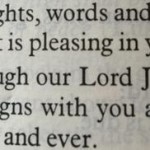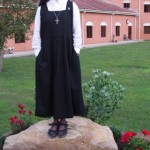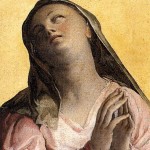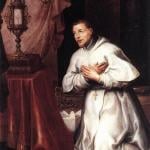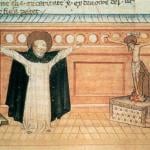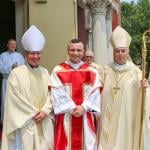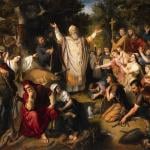“The Angel of the Lord appeared unto Mary,”
R: And she conceived by the Holy Spirit
— The Angelus
A nearby parish rings the Angelus bells twice a day, and I love it. Sometimes in Manhattan, you can hear a church ringing the Angelus. People hurry by; possibly few of them even hear the bells, and those who do may think they are simply tolling 6PM, or noon.
The Angelus is a devotion of the Church. At the tolling of the bells, signifying mid-day or evening prayer, a leader will intone, “The Angel of the Lord appeared unto Mary…” and the response is as above. There is more.
I imagine the Angelus, and the focus on the Annunciation, is one more reason why non-Catholics think of Catholics as “Mary-worshipers.”
We are not worshiping Mary, of course. But, after Christmas and Easter the Feast of the Annunciation is our most solemn day, because it is the day we celebrate the beginning of the whole pageant of salvation. As with the Incarnation and the Resurrection, the Annunciation provides rich and infinite spiritual nourishment for us, because it is a mystery that can never be fully grasped, it’s lessons never completely learned. There is always more insight to come; those insights tantalize and draw us ever closer to the Creator, who teaches us about ourselves, in Him.
So, while we do not “worship” Mary, we acknowledge her as “the New Eve,” a woman as important to the whole mechanism of our knowing God – of His giving Himself to us – as the first Eve. She is “the woman clothed with the sun.” She is the woman who “gave birth to a son, a male child, destined to rule all the nations with an iron rod. Her child was caught up to God and his throne…”
Yes, only a woman, but that’s one peculiarly blessed and holy woman. In medieval times people would approach the Mother of the King with due honor, asking her to intercede at the throne on their behalf. So do we. In Luke 11, when someone called out to Jesus, “Blessed is the womb that bore you and the breasts which gave you suckle” he corrected them about who what Mary was: “rather,” he said, “blessed are they who hear the word of God, and accept it.”
As always, the vespers for tonight anticipate the Feast – I’m sorry I did not have time to record them, as they’re particularly lovely. The antiphons and readings of sundown help set the mind’s focus on tomorrow’s Gospel reading.
Tonight we read:
This is what we proclaim to you:
what was from the beginning,
what we have heard,
what we have seen with our eyes,
what we have looked upon
and our hands have touched –
we speak of the world of life.
This life became visible;
we have seen and bear witness to it,
and we proclaim to you the eternal life
that was present to the Father
and became visible to us.
— 1 John 1:1-2
Our Dominican Nun pals over at Summit have a lovely tradition for this Vespers, whereby one of the novices – sometimes but not always the “newest” gives a sermon for the day. Their Sr. Maria Teresa preached instructively:
Eve ate the forbidden fruit to raise man to the level of God, and thus disfigured the very image of God within man. God, to redeem man, lowered Himself to become man. That which Eve ran from, God in His own person has embraced. Through Eve the image of God in man became disfigured, and so it pleased God that His image should come through a new Eve to inaugurate His new creation, His redemption of man. God’s new Eve was Mary.
Mary, alone among Eve’s descendants, was preserved from original sin at her conception. Mary and Eve were the only two women in history who were given the opportunity to choose the good without the hindrance of disorderly passions, the effects of original sin. Mary was completely free, as Eve was, to choose the good. Whereas Eve doubted God’s fatherly love for her, Mary fully believed that God is Father, that He could conceive the Child He promised within her womb. Eve grasped at the forbidden fruit and by that sin tore man from God. Mary received the promised Fruit in her womb, the Fruit that restored man to God. Eve conceived a son, Cain, who killed his brother because his brother found favor with God while he himself did not. Mary conceived a Son, Jesus, who gave up His own life for his brothers because His brothers did not find favor with God while He did. Eve used her freedom to choose death but Mary, in her freedom, chose life. Tertullian writes, “As Eve had believed the serpent, so Mary believed the angel. The delinquency which the one occasioned by believing, the other by believing effaced.”
As Eve’s sin was the cause of the condemnation for herself and for the whole human race, so too was Mary’s fiat the cause of salvation for us all. As man ran in ignorance from his own nature into the depths of damnation, God, in His supreme goodness, united Himself to man’s nature that man might be restored. To end with a quote from Augustine, “For this purpose the Eternal Word came upon earth, to make known to man how dearly God loved him.”
Sort of flies in the face of those who think of Christians and Catholics as denigrating women, doesn’t it? By the world’s measure, the power of a woman lies in what she “does.” By Christ’s measure – by God’s – woman is intrinsically powerful, simply in her being. She is afforded the power, freedom and respect to “make” or “break” mankind’s connection to the Creator.
Patrick O’ Hannigan has a more “whimsical” take.
Related:
Prod Mary
The Angel of the Lord, appeared unto Mary







